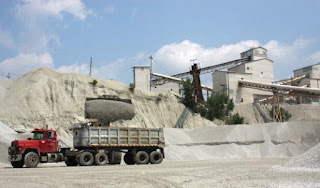Cement is a finely ground powder which, when mixed with water, forms a hardening paste of calcium silicate hydrates and calcium aluminate hydrates. Cement is used in mortar (to bind together bricks or stones) and concrete (bulk rock-like building material made from cement, aggregate, sand, and water). By modifying the raw material mix and the temperatures utilized in manufacturing, compositional variations can be achieved to produce cements with different properties. In the U.S., the different varieties of cement are denoted per the American Society for Testing and Materials (ASTM) Specification C-150.
Cement is produced from raw materials such as limestone, chalk, shale, clay, and sand. These raw materials are quarried, crushed, finely ground, and blended to the correct chemical composition. Small quantities of iron ore, alumina, and other minerals may be added to adjust the raw material composition. The fine raw material is fed into a large rotary kiln (cylindrical furnace) which rotates while the contents are heated to extremely high temperatures. The high temperature causes the raw material to react and form a hard nodular material called “clinker”. Clinker is cooled and ground with approximately 5 percent gypsum and other minor additives to produce Portland cement.
The heart of clinker production is the rotary kiln where the pyroprocessing stage occurs. The rotary kiln is approximately 20 to 25 feet (ft) in diameter and from 150 ft to well over 300 ft long; the kiln is set at a slight incline and rotates one to three times per minute. The kiln is most often fired at the lower end (sometimes, mid-kiln firing is used and new units incorporate preheating as well as precalcining), and the raw materials are loaded at the upper end and move toward the flame as the kiln rotates. The materials reach temperatures of 2500°F to well above 3000°F in the kiln. Rotary kilns are divided into two groups, dry-process and wet-process, depending on how the raw materials are prepared.
In wet-process kilns, raw materials are fed into the kiln as a slurry with a moisture content of 30 to 40 percent. To evaporate the water contained in the feedstock, a wet-process kiln requires additional length (in comparison to a dry kiln). Additionally, to evaporate the water contained in the slurry, a wet kiln consumes nearly 33 percent more kiln energy when compared to a dry kiln. Wet-process kilns tend to be older operations as compared to dry-processes where raw materials are fed into the process as a dry powder. There are three major variations of dry- process kilns in operation in the U.S.: long dry (LD) kilns, preheater (PH) kilns, and preheater/precalciner (PH/PC) kilns. In PH kilns and PH/PC kilns, the early stages of pyroprocessing occur before the materials enter the rotary kiln. PH and PH/PC kilns tend to have higher production capacities and greater fuel efficiency compared to other types of cement kilns.
Three important processes occur with the raw material mixture during pyroprocessing. First, all moisture is driven from the materials. Second, the calcium carbonate in limestone dissociates into CO2 and calcium oxide (free lime); this process is called calcination. Third, the lime and other minerals in the raw materials react to form calcium silicates and calcium aluminates, which are the main components of clinker. This third step is known as clinkering or sintering. The formation of clinker concludes the pyroprocessing stage.
Once the clinker is formed in the rotary kiln, it is cooled rapidly to minimize the formation of a glass phase and ensure the maximum yield of alite (tricalcium silicate) formation, an important component for the hardening properties of cement. The main cooling technologies are either the grate cooler or the tube or planetary cooler. In the grate cooler, the clinker is transported over a reciprocating grate through which air flows perpendicular to the flow of clinker. In the planetary cooler (a series of tubes surrounding the discharge end of the rotary kiln), the clinker is cooled in a counter-current air stream. Reciprocating type grate coolers can also be used to cool the clinker. The cooling air is used as secondary combustion air for the kiln to improve efficiency since the cooling air has been preheated during the process of cooling the clinker.
After cooling, the clinker can be stored in the clinker dome, silos, bins, or outside in storage piles. The material handling equipment used to transport clinker from the clinker coolers to storage and then to the finish mill is similar to that used to transport raw materials (e.g. belt conveyors, deep bucket conveyors, and bucket elevators). To produce powdered cement, the nodules of clinker are ground to the consistency of powder. Grinding of clinker, together with additions of approximately 5 percent gypsum to control the setting properties of the cement can be done in ball mills, ball mills in combination with roller presses, roller mills, or roller presses. While vertical roller mills are feasible, they have not found wide acceptance in the U.S. Coarse material is separated in a classifier that is re-circulated and returned to the mill for additional grinding to ensure a uniform surface area of the final product.






